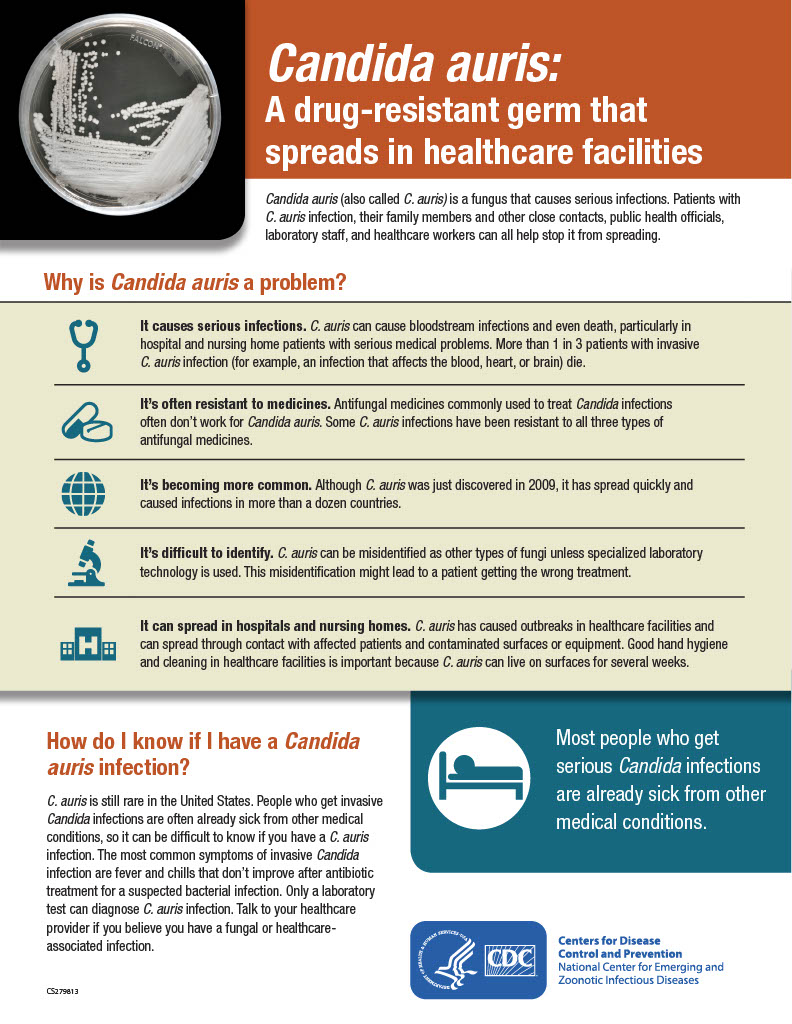Candida Auris – Attacking a new pathogen in healthcare
A relatively new drug resistant pathogen called Candida Auris (C. Auris) has recently been making headlines related to infection outbreaks in hospitals and nursing homes. This post discusses infection control issues associated with the pathogen and appropriate disinfectants that are effective against C. Auris.
What is it? Candida Auris is an emerging fungal pathogen that causes serious infections and has been responsible for outbreaks among hospitalized patients. Below is a FACT SHEET from the CDC on C. Auris.
Why is it a problem? Candida auris causes infections that are resistant to normal anti-fungal drugs used to treat Candida infections. Most susceptible are hospitalized or nursing home patients with serious medical problems. Currently, 1 in 3 people with a C. auris infection die.
Candida auris related illnesses are difficult to identify in patients and can be mis-diagnosed. Difficulty in identifying a patient illness related to Candida auris allows it spread rapidly.
What Disinfectants are effective on C. Auris? There are few disinfectants with specific efficacy claims for C. Auris, including most quat disinfectants. So, if C. Auris becomes an issue, one should verify the disinfectant they are using has an efficacy claim for C. Auris. There is a list of disinfectants that have demonstrated efficacy on C-Auris. The EPA has identified a list of approved disinfectants called LIST P.
Current CDC information: For specifics on the disease and steps needed to identify, treat, and prevent infection, one should consult the Centers for Disease Control for guidance and recommendations. A link directly to the CDC’s Candida Auris webpage can be found at the bottom of this post.
The paragraphs below quote the environmental disinfecting recommendations for C. Auris found on the CDC webpage.
“Coordinate with environmental services to monitor and ensure the patient care environment is cleaned using a disinfectant with an Environmental Protection Agency claim for C. auris or, if not available, for Clostridioides difficile. These products can be found at www.cdc.gov/fungal/candida-auris/c-auris-infection-control.html. Some disinfectants used in healthcare facilities (e.g., quaternary ammonium compounds [QACs]) may not be effective against C. auris, despite claims about effectiveness against C. albicans or other fungi. Work with the environmental services team to monitor the cleaning process.”
Disinfectant Products Effective Against Candida Auris:
Multi-Clean makes a hard surface disinfectant with efficacy toward Candida Auris. It is pleasant to use and much less harsh than many of the acetic acid/peroxide based or bleach based disinfectant products.
Multi-Clean 128 E-FECTicide is a neutral disinfectant cleaner with broad based efficacy against pathogens including many antibiotic resistant bacteria (5 min contact time). It also has a fungi claim for Candida Auris. The 128 E-FECTicide is an effective virucide and is effective on SARS-CoV-2, the cause of COVID-19 with a 60 second contact time.
Multi-Clean 128 E-FECTicide
EPA Reg #6836-365-5449
Dilution Rate for most pathogens: 1 oz per gallon of water. (Contact time: 5 minutes or less).
Dilution Rate for C-Auris: 8 oz per gallon of water.(Contact time: 10 min).
To learn more, visit our website Disinfectants Web Page


